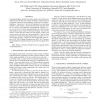Free Online Productivity Tools
i2Speak
i2Symbol
i2OCR
iTex2Img
iWeb2Print
iWeb2Shot
i2Type
iPdf2Split
iPdf2Merge
i2Bopomofo
i2Arabic
i2Style
i2Image
i2PDF
iLatex2Rtf
Sci2ools
ICASSP
2011
IEEE
2011
IEEE
Variational approximation of long-span language models for lvcsr
Long-span language models that capture syntax and semantics are seldom used in the first pass of large vocabulary continuous speech recognition systems due to the prohibitive search-space of sentencehypotheses. Instead, an N-best list of hypotheses is created using tractable n-gram models, and rescored using the long-span models. It is shown in this paper that computationally tractable variational approximations of the long-span models are a better choice than standard n-gram models for first pass decoding. They not only result in a better first pass output, but also produce a lattice with a lower oracle word error rate, and rescoring the N-best list from such lattices with the long-span models requires a smaller N to attain the same accuracy. Empirical results on the WSJ, MIT Lectures, NIST 2007 Meeting Recognition and NIST 2001 Conversational Telephone Recognition data sets are presented to support these claims.
| Added | 21 Aug 2011 |
| Updated | 21 Aug 2011 |
| Type | Journal |
| Year | 2011 |
| Where | ICASSP |
| Authors | Anoop Deoras, Tomas Mikolov, Stefan Kombrink, Martin Karafiát, Sanjeev Khudanpur |
Comments (0)

